|
|
LRTC Emergency Response Team
INFORMATION SHEET
Basic Rope Rescue Systems
|
Updated September 9, 2019
|
This information sheet is primarily intended for persons associated with or working with the LRTC Technical Large Animal Rescue Team, however the information may be useful to other groups or private individuals who may wish to similarly equip their own technical large animal rescue teams.
|
|
Whether lowering a rescuer or a Stokes basket down an embankment, extricating a large animal using haul lines, raising a victim in the Stokes basket or loading an animal into a transport trailer using the Rescue Glide, it is often mission critical to be able to quickly and reliably assemble safe and effective rope systems that will provide the mechanical advantage needed to accomplish the assignment.
This information sheet is intended to provide review information and guidelines involving basic, rapid deployment systems. Links to reputable sites that provide more complex rope rescue system options are provided at the end of this feature.
The basic elements covered here include equipment required, basic knots, proper anchor points, and our most commonly used Z-rig, the 3:1 system.
|
|
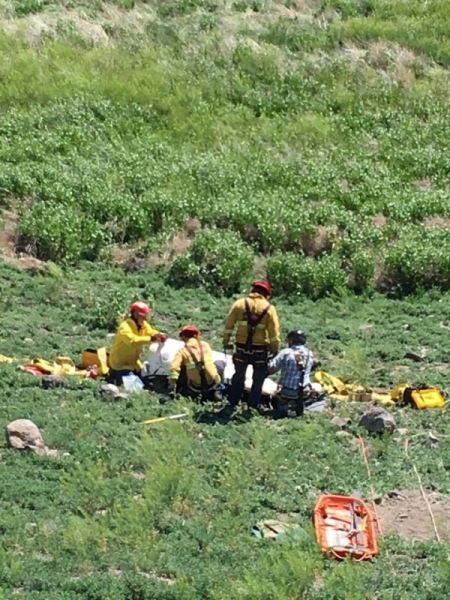
|
|
The equipment typically deployed for these evolutions include:
- Rescue / Haul lines
- Certified "Life Safety" rescue rope for human rescues
- Utility rope for animal rescues and stabilization
- Webbing
- Prusiks
- Pulleys
- Appropriately rated carabiners
- Progress capture devices
- Braking and descending devices
LIFE SAFETY AND HAUL LINES
Our "Life Safety" and "Utility" rope bags are clearly marked. Except in extraordinary circumstances the Life Safety rope should only be used for human life safety operations and the rope log must be updated any time the "Life Safety" rope is used or inspected. (NFPA 1983 requirement.) We log the activities of all of our 13mm kernmantle rope.
In addition to these rescue and heavy utility lines, there are various personal safety, water safety, throw bags and minor utility lines available which are described later in this information series.
|
1/2-inch HTP static Life Safety rope, rated at 9,891 Lbs.
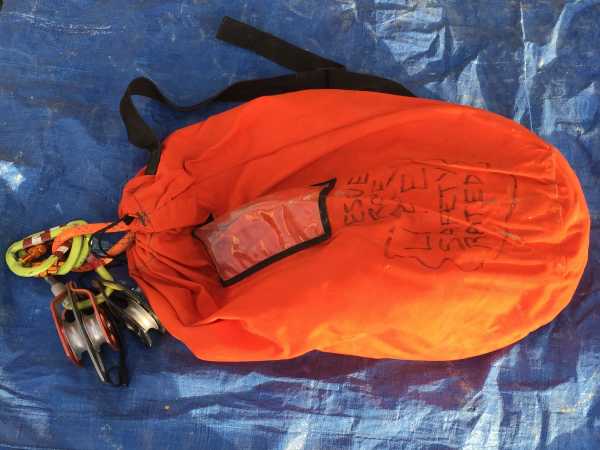
|
1/2-inch HTP utility rope, rated at 8,992 Lbs.
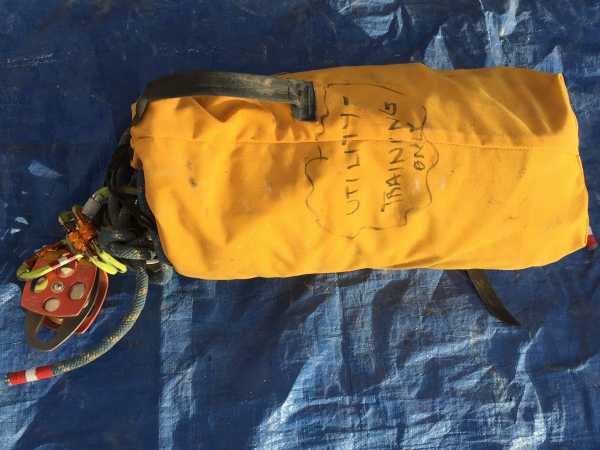
|
|
Key Points!
The traditional safety factor for human life loads is 15:1.
9,891 Lb. rated ropes can safely haul a load of 650 Lbs.; the combined weight of victim, rescue gear and the potential load applied by rescuers assisting in removal such as being brought up up low angle slopes. (Some jurisdictions having equipment with improved technology may employ a lower safety factor, however we will design our systems with the intent of providing the traditional 15:1 safety factor.)
Livestock loads require a 5:1 safety factor. An 8,992 Lb. rated rope can safely haul a livestock load of 1,800 Lbs.
Heavier livestock or anchor loads may require the use of the 5/8-inch utility rope. Our 5/8-inch rope is no longer certified for life safety use due to age.
* The safe application of a rope rescue system can be limited by the grip strength of the person(s) pulling on the rope unless a progress capture device is installed to prevent the inadvertent lowering of the load.
5/8-inch utility rope, commonly referred to in the field as the "big rope."
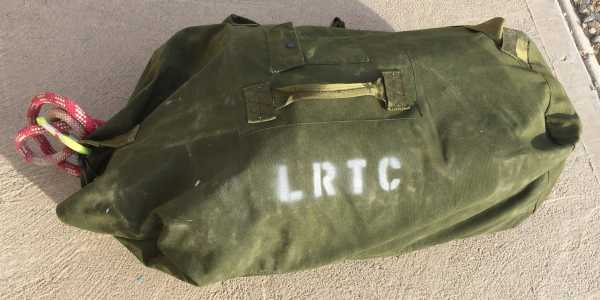
For water rescues, the first out rescue units each have water rescue throw bags that contain 50 feet of polypropylene rope in a floating bag. A good video on how to properly use water rescue throw bags can be viewed here.
|
Floating water rescue throw bags.
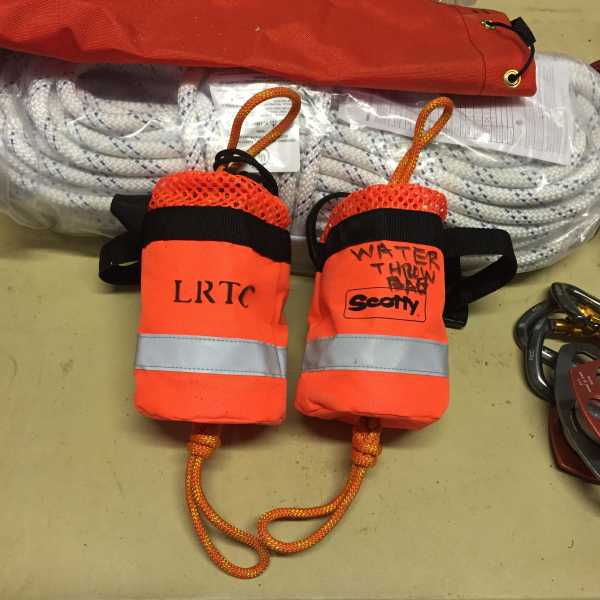
|
One throw bag clipped onto the life vest bag.
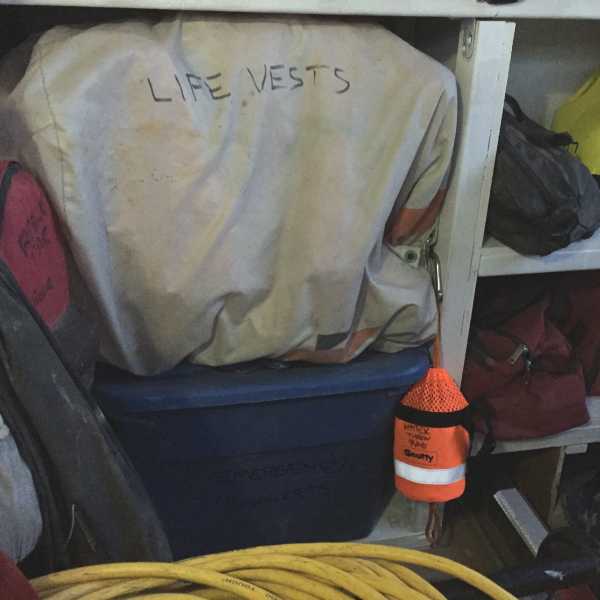
|
Typical back pack type rope bag and accessories.
1 large carabiner, 5 standard carabiners, one "Bear Paw" rigging plate
1 double sheave pulley, 2 single sheave pulleys, 1 "Gibbs"style ascender.
(Life safety rope bags also carry a Figure-8 descender.)
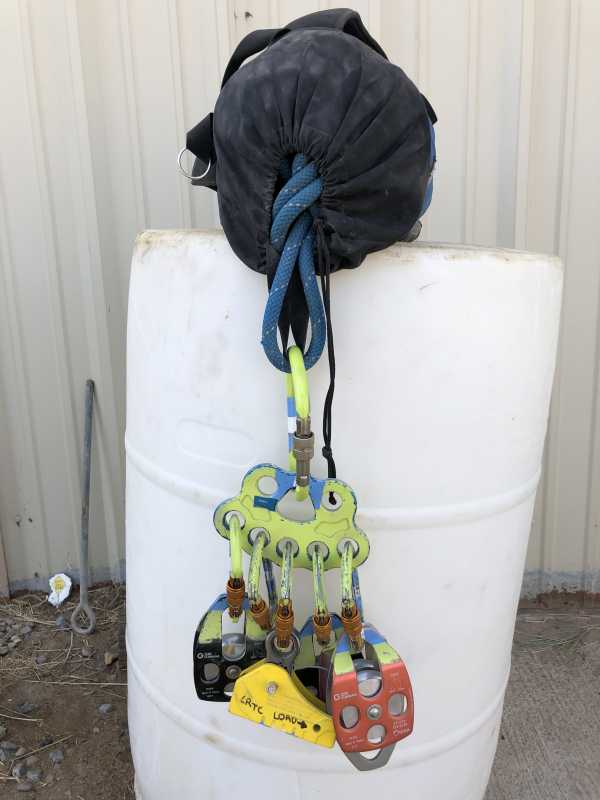
|
WEBBING
Webbing is stored in the storage box labeled "Rescue Glide Box 1." Various lengths of 1-inch webbing rated at 7,000 Lbs. are available. Webbing lengths are represented by standard colors with each color representing a specific length. The lengths are marked at both ends of each piece and a mark indicates the midpoint of each piece. A 15:1 safety factor provides a load rating of 466 Lbs. A 5:1 safety factor provides a load rating of 1400 Lbs.
(Our color coding for length conforms to current USAR standards.)
|
|
|
- Black = 25 Ft. (2 pieces)
- White = 20 Ft. (2 pieces)
- Orange=17 Ft. (2 pieces)
|
- Blue = 15 Ft. (2 pieces)
- Yellow = 12 Ft. (2 pieces)
- Green = 5 Ft. (2 pieces)
|
Various lengths in Rescue Glide Box 1.
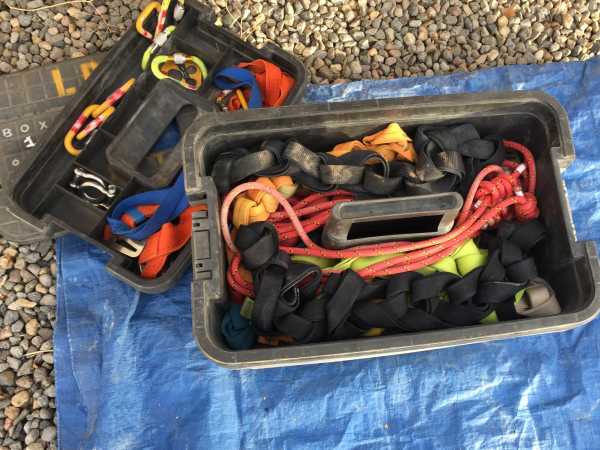
|
Examples of length markings.
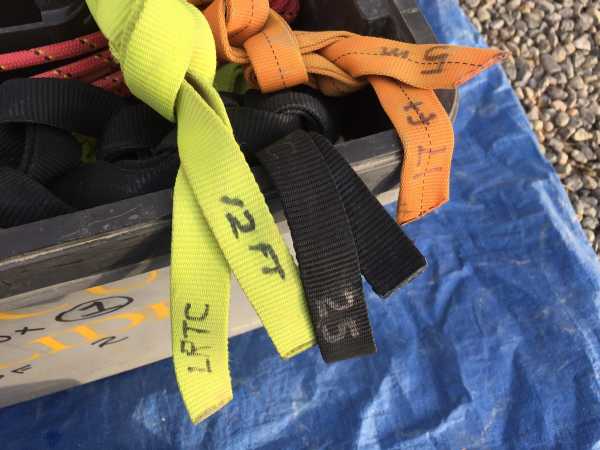
|
|
PRUSIKS
Our Prusiks are made from 8 mm accessory cord. Our orange Prusiks are rated for 4,046 Lbs. (270 Lbs. at 15:1, 800 Lbs. at 5:1.) A few green Prusiks remain but have aged out for rescue service but may be used to bundle and carry light weight equipment.
Prusiks should not be used as primary load bearing for weights that exceed their safety factor ratings! They could be doubled up or backed up by appropriate lengths of webbing.
We carry Prusiks in two working lengths, 20 inches and 36 inches. In addition we carry Purcells that are adjustable in length that are carried in a separate bag.
|
Prusik lengths carried: 20-inch & 36-inch.
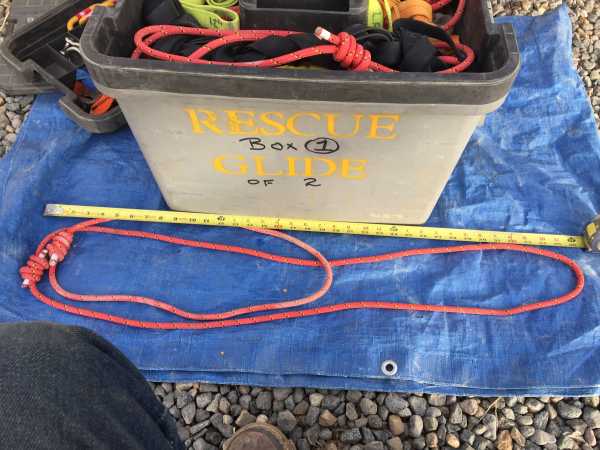
|
Purcells.
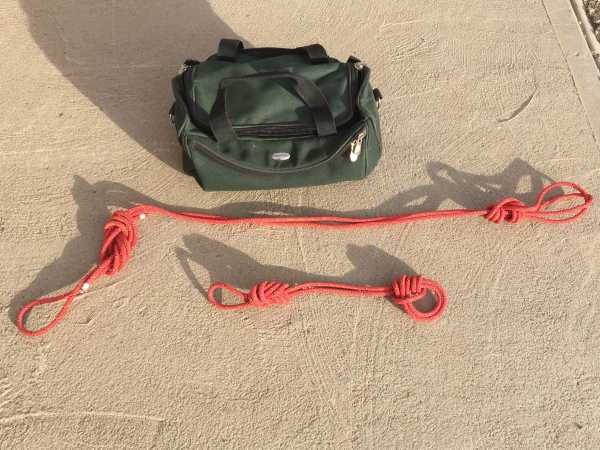
|
|
PULLEYS
Each rope bag has attached to it one large carabiner, five standard carabiners, an ascender, one double sheave pulley and two single sheave pulleys that are usually arranged on a "Bear Paw" rigging plate. The pulleys are rated at 32kN (about 7,200 Lbs.) The compliment of pulleys attached to each rope bag can rig 3:1, 4:1 and 5:1 systems. Multiple sets can be used to configure more complex systems, changes of direction, etc.
|
How the bags and accessories are typically stored.
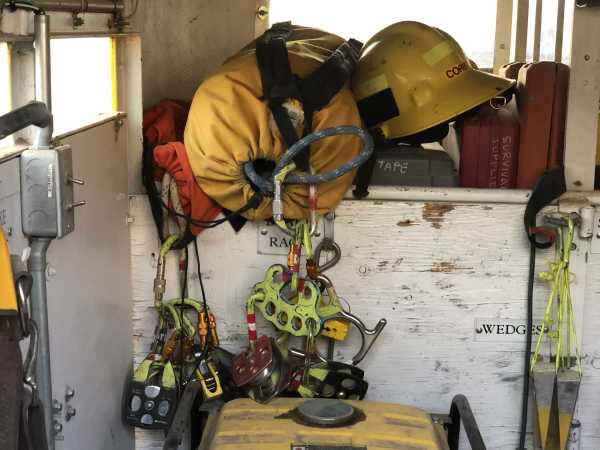
|
"Load and go" field application.
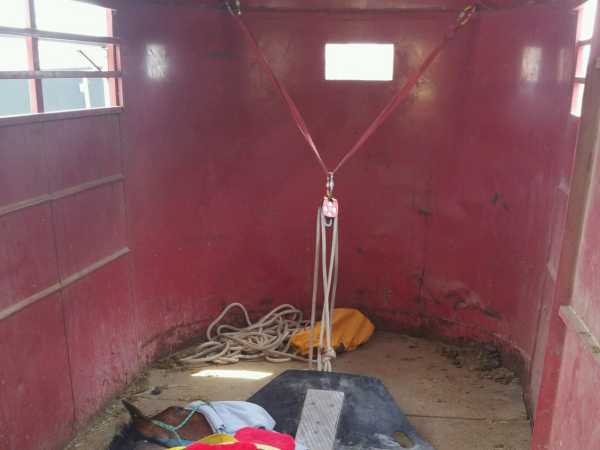
|
|
CARABINERS
The rescue units carry a spectrum of carabiner shapes and sizes. For simplicity in determining safe loading, they are color coded into two categories.
Carabiners rated at 27 kN (6,069 Lbs.) and greater are painted lime yellow. These carabiners are suitable for lifeline, livestock and other heavy / critical loads.
Carabiners rated below 27 kN are painted school bus yellow (orange.) These carabiners are associated with personal safety (tag) lines and personal accessory cord utility bags.
Most rope bags also have two (2) large steel NFPA compliant carabiners.
|
Left, livestock and life safety loads. Right, light utility loads.
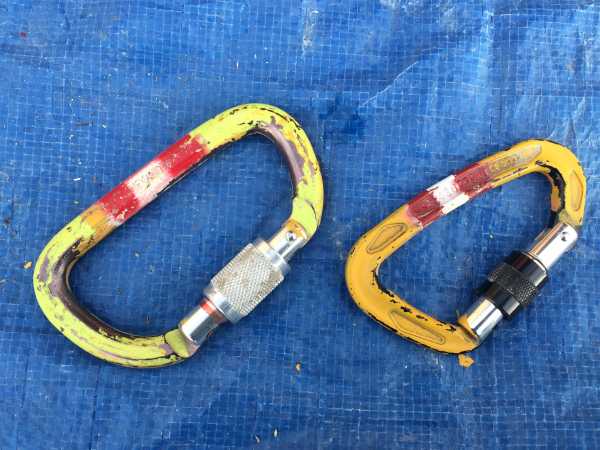
|
Carabiners rated for tag lines and securing light objects.
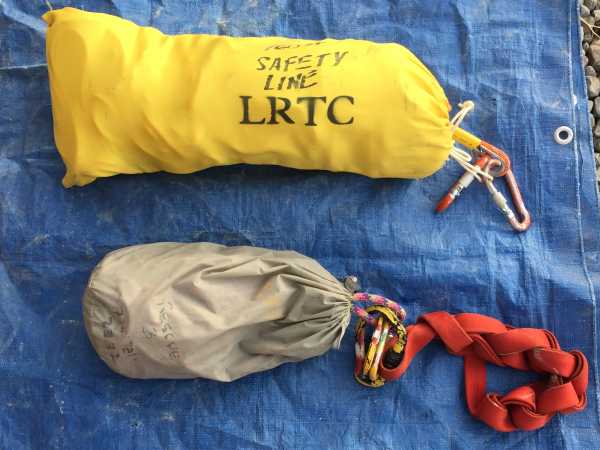
|
|


















